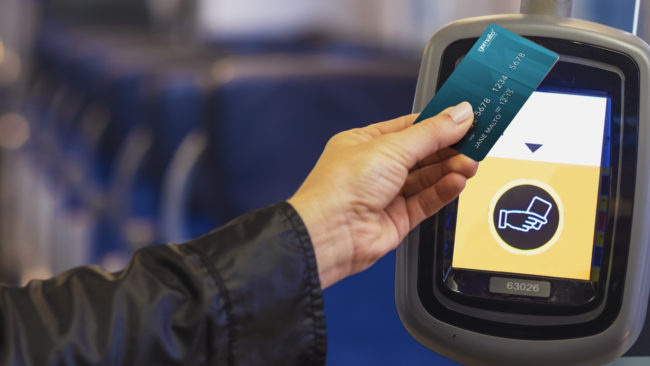Bank card instead of travel card
We have already discussed the possibility of paying for public transport by touching a smartphone or using smart watches to the payment terminal. And in recent months and years we have seen a number of new achievements in this area.

As one of the examples where the potential of contactless technologies was demonstrated, we can cite the European Football Championship 2016. The championship itself was remembered by many fans for the triumph of Portugal and the unlucky game of the England team against little known Icelanders at that time, but for us the real event was the use of public transport Lille contactless bracelets. Thanks to this new payment system, the city has managed to reduce queues and make it easier for fans to travel to the stadium.
At the same time, the growing popularity of contactless payment services, such as Apple Pay and Android Pay, is changing people's habits when paying for services, whether it is in public transport or lunch in a restaurant. No less rapidly developing service Samsung Pay. Since May 16, Samsung Pay users have been able to use this service to pay for travel in London transport. Such solutions based on NFC technologies fully meet the standards of contactless tickets, ensuring high speed and safety of work.
')
In the #MyNFCDay video series, we showed how this new technology affects the lives of people in major cities around the world - including in London, New York, and Singapore.
The MasterCard payment system pays attention to one more dynamically developing direction of contactless payment technologies - EMV bank cards. If for any reason you don’t like to pay with a mobile phone or wearable device, there is another alternative to an “independent” travel ticket - you can pay for travel by train or bus using your EMV card. According to a study of the international payment system, today EMV bank cards are accepted to pay for public transport in 80 cities around the world.
There are two formats for working with bank cards. An open system (open-loop) implies the ability to accept any contactless EMV standard bank cards, but there is another option - this is a combined card that combines the functions of a payment card and a ticket at once. But in this case, the issue of a special card is required, while the bank issuing the card has the opportunity to expand and refine its product. We are pleased to note the growing popularity of both of these approaches, because in order to offer passengers maximum convenience on public transport, a universal payment mechanism is needed in which the most diverse NFC solutions are supported.
Whatever happens next, it is obvious that today, thanks to the development of contactless technology, consumers are getting more and more different possibilities for making payments. Long lines become history.
Do you use contactless payments? Share your impressions below.

As one of the examples where the potential of contactless technologies was demonstrated, we can cite the European Football Championship 2016. The championship itself was remembered by many fans for the triumph of Portugal and the unlucky game of the England team against little known Icelanders at that time, but for us the real event was the use of public transport Lille contactless bracelets. Thanks to this new payment system, the city has managed to reduce queues and make it easier for fans to travel to the stadium.
At the same time, the growing popularity of contactless payment services, such as Apple Pay and Android Pay, is changing people's habits when paying for services, whether it is in public transport or lunch in a restaurant. No less rapidly developing service Samsung Pay. Since May 16, Samsung Pay users have been able to use this service to pay for travel in London transport. Such solutions based on NFC technologies fully meet the standards of contactless tickets, ensuring high speed and safety of work.
')
In the #MyNFCDay video series, we showed how this new technology affects the lives of people in major cities around the world - including in London, New York, and Singapore.
The MasterCard payment system pays attention to one more dynamically developing direction of contactless payment technologies - EMV bank cards. If for any reason you don’t like to pay with a mobile phone or wearable device, there is another alternative to an “independent” travel ticket - you can pay for travel by train or bus using your EMV card. According to a study of the international payment system, today EMV bank cards are accepted to pay for public transport in 80 cities around the world.
There are two formats for working with bank cards. An open system (open-loop) implies the ability to accept any contactless EMV standard bank cards, but there is another option - this is a combined card that combines the functions of a payment card and a ticket at once. But in this case, the issue of a special card is required, while the bank issuing the card has the opportunity to expand and refine its product. We are pleased to note the growing popularity of both of these approaches, because in order to offer passengers maximum convenience on public transport, a universal payment mechanism is needed in which the most diverse NFC solutions are supported.
Whatever happens next, it is obvious that today, thanks to the development of contactless technology, consumers are getting more and more different possibilities for making payments. Long lines become history.
Do you use contactless payments? Share your impressions below.
Source: https://habr.com/ru/post/337504/
All Articles